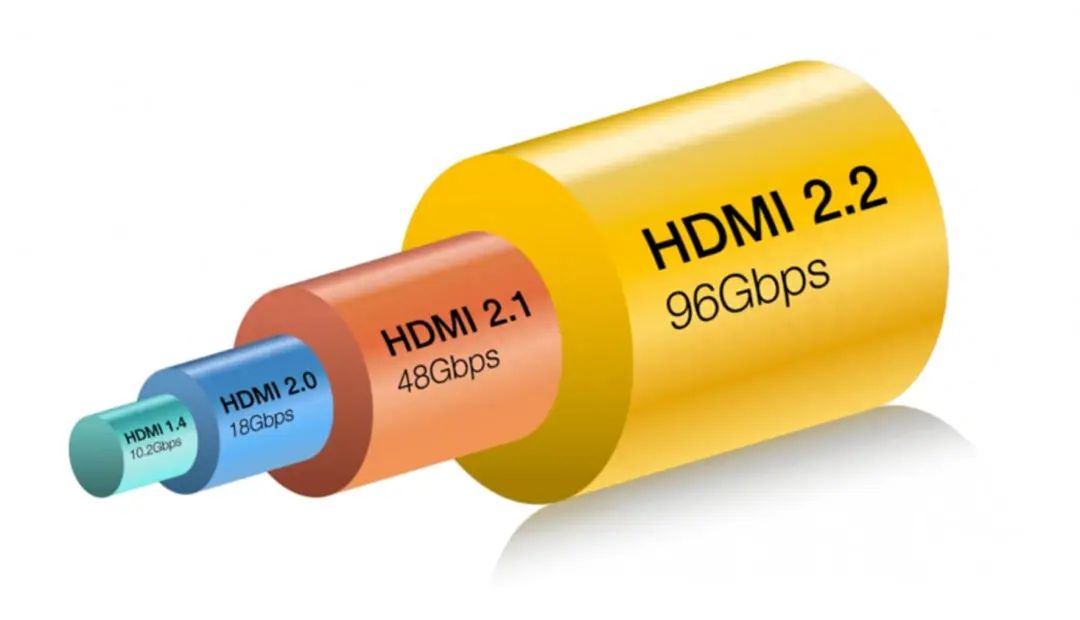The HDMI Forum, which is responsible for formulating HDMI transmission standards, officially launched HDMI version 2.2 at CES 2025. This version continues to be upgraded on HDMI 2.1, providing greater transmission bandwidth to meet high resolution and high refresh rate requirements.
Core upgrade of the HDMI 2.2 specification
1. Bandwidth upgraded to 96Gbps
The biggest highlight of the specification is that its bandwidth has jumped from 48Gbps in the previous generation to 96Gbps, achieving a significant leap in transmission speed. This improvement allows creators to produce and distribute more sophisticated and complex video content, such as uncompressed 8K/120Hz signals or higher resolution and refresh rate combinations.
In addition, support for color depth has also been enhanced, allowing lossless transmission at 12-bit or higher color depth, further improving image quality.
2. Fixed Rate Link
Technological Innovation to meet the new high-bandwidth requirements, HDMI 2.2 introduces the next generation of fixed-rate link technology. This innovation can support 120Hz refresh rates at resolutions up to 7680x4320 pixels, or lower refresh rates at higher resolutions. FR Link technology simplifies data transmission and reduces the need for complex encoding and decoding, thereby reducing latency and improving the efficiency of the system.
3. Latency Indication Protocol (LIP)
The newly added Latency Indication Protocol (LIP) is an important audio and video synchronization optimization measure. It marks the timestamp information of each audio sample at the sending end and adjusts the playback timing based on these timestamps at the receiving end to ensure that the accuracy of audio and video synchronization reaches an unprecedented level. This is especially important for home theater systems, game consoles, and other multi-device interconnection scenarios.
4. Broad application prospects
In addition to home entertainment, HDMI 2.2 has broad application potential in the professional market. For example, in medical imaging, it can provide real-time high-definition image transmission; in the fields of virtual reality (VR) and augmented reality (AR), it can bring a more realistic and low-latency interactive experience; and in the digital signage industry, it will help create larger, clearer public display solutions.

Timeline of HDMI Standards Releases
HDMI 1.0: Released on December 9, 2002. This was the first version, which introduced the basic capabilities for a single-cable digital audio and video connection1.
HDMI 1.1: Released on May 20, 2004. This version added support for DVD Audio.
HDMI 1.2: Released on August 8, 2005. It added support for One Bit Audio, used on Super Audio CDs, and allowed for the connection of PC sources.
HDMI 1.2a: Released on December 14, 2005. This version introduced Consumer Electronic Control (CEC) features.
HDMI 1.3: Released on June 22, 2006. It increased the maximum data rate to 10.2 Gbps and added support for Dolby TrueHD and DTS-HD Master Audio, as well as additional color spaces.
HDMI 1.4: Released on May 28, 2009. This version introduced Ethernet channel, Audio Return Channel (ARC), 3D capabilities, and support for 4K resolution.
HDMI 2.0: Released on September 4, 2013. It increased the maximum bandwidth to 18 Gbps, allowing for 4K video at 60 frames per second.
HDMI 2.0a: Released on April 8, 2015. It added support for High Dynamic Range (HDR) video.
HDMI 2.0b: Released in March 2016. It included support for Hybrid Log-Gamma (HLG) for HDR.
HDMI 2.1: Released on November 28, 2017. This version significantly increased the bandwidth to 48 Gbps, supporting 8K resolution at 60Hz and 4K at 120Hz, along with Dynamic HDR and enhanced audio return channel (eARC)
HDMI 2.1a: Released in February 2022. This version introduced Source-Based Tone Mapping (SBTM).
HDMI 2.1b: Released in August 2023. This update is an incremental improvement over HDMI 2.1a
Relate Article:
The Difference between HDMI 2.1 and 2.0: A Guide to Choose Cable Fit Your Needs
Tag:HDMI,HDMI 2.2




